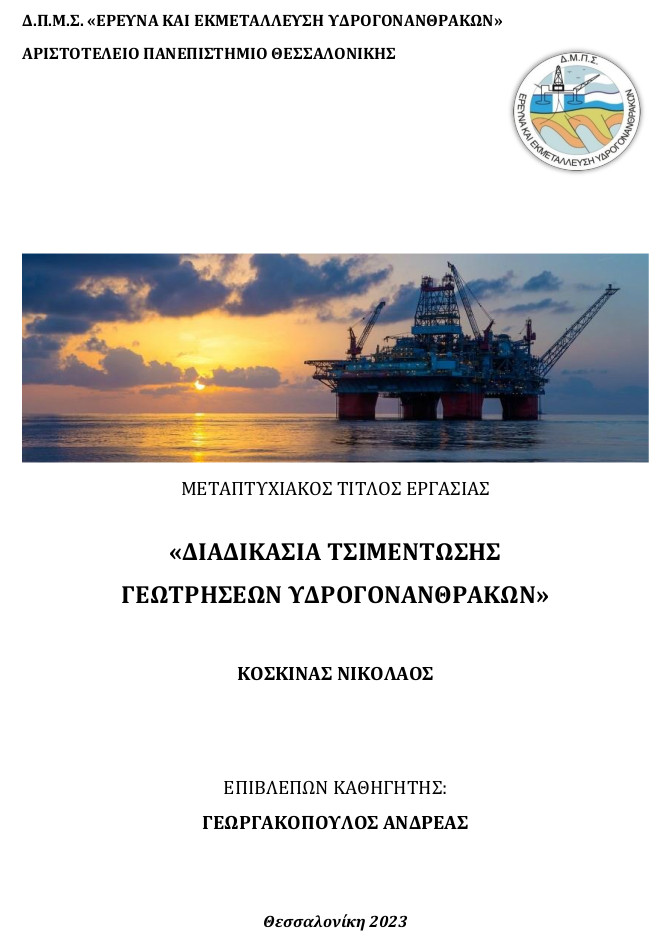
Διαδικασία τσιμέντωσης γεωτρήσεων υδρογονανθράκων = Oil and gas well cementic operation.
Περίληψη
Cementing is one of the most principal processes during the exploitation of hydrocarbons and specifically during the drilling stage. Nevertheless, there are several stages, which include sometime more complex and sometime simpler procedures. The stages of hydrocarbon exploration and exploitation include research, exploration, drilling, production and of course abandonment. The term cementing describes the process of filling a specific part of the borehole with a mixture of water, cement and other additives. This process is directly intertwined with the piping process. It is distinguished into primary cementation and restoration cementation. The most common cementing method is the two-plug method. By the term cement slurry we refer to a mixture of cement, water and other additional materials. The cement slurry should meet certain conditions so that it can insulate the formations during the drilling process and avoid various failures. The American Petroleum Institute (API) established the use of a ranking scale of various types of cement, where the appropriate type should be selected, depending on the conditions in each well and its various depths. The most common type of cement used is Portland cement. Although now each cement industry follows its own method, the design of the cement slurry is very important for the completion of the project. In recent years, the global oil and gas industry has been under pressure to increase production in order to meet global energy demand. A major key factor that has been developed to fulfill this necessity is the reserves, which exist beneath salt formations. Therefore, the drilling of a well, the tubing, and cementing, can be special challenge. Finally, it has been observed that the most problems in a well, over time, are related to mistakes during the cementing process.
Πλήρες Κείμενο:
PDFΑναφορές
ΕΛΛΗΝΙΚΗ
Γεωργακόπουλος Α. (2015). Κοιτασματολογία Πετρελαίου. Αριστοτέλειο Πανεπιστήμιο Θεσσαλονίκης. Θεσσαλονίκη.
Μπιωτάκη Α. (2014). Μελέτη μηχανικών ιδιοτήτων τσιμέντων γεωτρήσεων υδγρογονανθράκων με χρήση οργάνων NMR και με δοκιμές αντοχής σε μονοαξονική θλίψη. Πολυτεχνείο Κρήτης, Χανιά, Ελλάδα.
Σπηλιωτάκος Χ. (2018). Σχεδιασμός κατευθυνόμενων γεωτρήσεων υδρογονανθράκων, Εθνικό Μετσόβιο Πολυτεχνείο, Αθήνα.
Σταματάκη Σ. (2017). Διαφάνειες μαθήματος «Όρυξη γεωτρήσεων» του Δ.Μ.Π. Έρευνα και Εκμετάλλευση Υδρογονανθράκων. Θεσσαλονίκη.
Τσίπρας Θ. (2015). Χαρακτηρισμός και Μελέτη Ενυδάτωσης Τσιμέντων Γεωτρήσεων τύπου G. Εθνικό Μετσόβιο Πολυτεχνείο, Αθήνα.
ΞΕΝΗ
Abdel-Alim H., Fouad K., J. (1994). King Saud University, Vol. 6, Eng. Sci. (2)3, pp. 265-279 (A.H. 1414/1994).
Baker H. (1995). Drilling engineering workbook.
Bernhart M. (2014). Well Abandonment Strategies.
Catala G., De Montmollin V., Hayman A., et.al. (1991). Modernizing Well Cementing Design and Evaluation. Oilfield Review, April 1991.
Danilović D., Karović Maričić V., Ristović I. (2006). Faculty of Mining and Geology, University of Belgrade, Belgrade, Serbia.
Dastgerdi M. E., Manshad A. K., Mohammadi A. H. (2020). Optimization of perforated liner parameters in horizontal oil wells. Journal of Petroleum Exploration and Production Technology, 10, p. 3505–3514.
Hasanzadeh B. (2017). Testing and modeling of the thixotropic behavior of cementing material. University of Louisville, Kentucky.
Johnson M., Thomas P. S., Vessalas K. & Baweja D. (2015). Role of Ettringite in Expansion and Cracking Potential in Steam Cured Precast Concrete Elements.
Centre for Built Infrastructure Research, University of Technology Sydney.
Ko Ko Kyi, Goh Jin Wang A. (2015). Issues with Cement Bond and Cement Evaluation Logs - Case studies from offshore Malaysia. International Petroleum Technology Conference, Doha, Qatar.
Lavrov A., Torsæter M. (2016). Physics and Mechanics of Primary Well Cementing.
Lubej S., Ivan A., Jelušič P., Kosec L., Ivanič A. (2014). The effect of delayed ettringite formation on fine grained aerated concrete mechanical properties. Science and Engineering of Composite Materials, vol. 23, no. 3, 2016, pp. 325-334.
Messenger J. U. (1978). Cementing against evaporites. United States Patent.
Nelson Erik B. (1990). Well cementing. Schlumberger Educational Services. Sugar Land, Texas.
Perez M. A., Clyde R., D’Ambrosio P., Idrael R., Leavitt T., Nutt L. (2008). Meeting the subsalt challenge, Oilfield review, Autumn.
Piklowska A. (2017). Cement slurries used in drilling – types, properties, application. Department of Drilling, Oil and Gas, AGH University of Science and Technology. Cracow, Poland. Materials Science 149-165.
Portland Cement Association. (2001). Ettringite Formation and the Performance of Concrete.
Sabbins L. F. (1990). Problems in Cementing Horizontal wells. Haliburton Services. J Pet Technol 42 (04): 398–400.
Wamala Khaemba Α. (2014). Well design, cementing techniques and well work-over to land deep production casings in the Menengai Field. Geothermal Development Company, Ltd. Nakuru, Kenya.
Zoback Mark D., Kohli Arjun H. (2019). Horizontal Drilling and Multi-Stage Hydraulic Fracturing. Stanford University, California. Cambridge University Press. pp. 233-262.
ΙΣΤΟΣΕΛΙΔΕΣ
www.histonium.net
www.petrowiki.spe.org.
www.production-technology.org
www.youtube.com/watch?v=fBQCQ6HL2Yw
www.petroblogweb.wordpress.com
www.glossary.oilfield.slb.com
Εισερχόμενη Αναφορά
- Δεν υπάρχουν προς το παρόν εισερχόμενες αναφορές.
